Birmingham Town Hall
Birmingham Town Hall is a concert hall and venue for popular assemblies opened in 1834 and situated in Victoria Square, Birmingham, England. It is a Grade I listed building.[1]
| Birmingham Town Hall | |
|---|---|
 Birmingham Town Hall, March 2009 | |
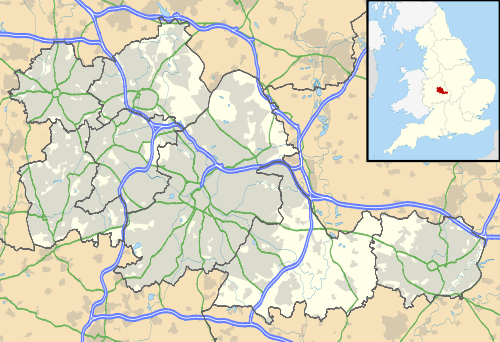 Birmingham Town Hall Location within West Midlands county | |
| General information | |
| Type | Concert hall |
| Architectural style | Classical |
| Location | Victoria Square |
| Town or city | Birmingham |
| Country | United Kingdom |
| Coordinates | 52.4796°N 1.9037°W |
| Current tenants | Performances Birmingham Ltd |
| Construction started | 27 April 1832 |
| Opened | 7 October 1834 |
| Renovated | 1996—2007 |
| Cost | 25,000 Pound sterling |
| Renovation cost | 35 million Pound sterling |
| Owner | Birmingham City Council |
| Design and construction | |
| Architect | Joseph Hansom & Edward Welch |
| Main contractor | Thomas & Kendall |
| Renovating team | |
| Architect | Rodney Melville Partners |
| Renovating firm | Wates Group |
| Other information | |
| Seating capacity | 1,086 |
| Website | |
| www | |
Listed Building – Grade I | |
| Official name | Birmingham Town Hall |
| Designated | 25 April 1952 |
| Reference no. | 1343161 |
The hall underwent a major renovation between 2002 and 2008. It now hosts a diverse programme of events including jazz, world, folk, rock, pop and classical concerts, organ recitals, spoken word, dance, family, educational and community performances, as well as annual general meetings, product launches, conferences, dinners, fashion shows, graduation ceremonies and broadcasts.
History
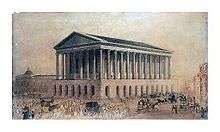
The building was created as a home for the Birmingham Triennial Music Festival established in 1784, the purpose of which was to raise funds for the General Hospital, after St Philip's Church (later to become a cathedral) became too small to hold the festival, and for public meetings.[2]
Two sites were considered by the Birmingham Street Commissioners for the construction of a concert hall in the city; Bennetts Hill and the more expensive Paradise Street site. The latter was chosen and a design competition was launched which resulted with the submission of 67 designs including one by Charles Barry, whose design for the King Edward's School on New Street was then under construction.[3]
Joseph Hansom, of Hansom cab fame, and Edward Welch were chosen as the architects and they expressed that they expected the construction cost to be £8,000 (equivalent to £750,000 in 2019).[4] The first of the monumental town halls that would come to characterise the cities of Victorian England,[5] Birmingham Town Hall was also the first significant work of the 19th-century revival of Roman architecture,[6] a style chosen here in the context of the highly charged radicalism of 1830s Birmingham for its republican associations.[6] The design was based on the proportions of the Temple of Castor and Pollux in the Roman Forum.[7] "Perfect and aloof" on a tall, rusticated podium, it marked an entirely new concept in English architecture.[7]
Hill of London was hired to build the 6,000 pipe organ for £6,000. Construction began on 27 April 1832 with an expected completion date of 1833.[8] However, Hansom went bankrupt during construction, having tendered too low. The contractors were also losing money. Three guarantors donated money for the building; W. P. Lloyd, John Welch and Edward Tench. With the injection of this money, the building was successfully opened for the delayed Music Festival on 7 October 1834.[9]
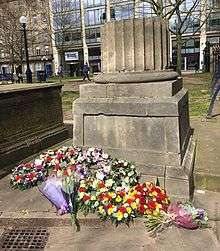
During construction, on 26 January 1833, two workers were killed when a 70-foot crane constructed to install the roof trusses broke and the pulley block failed. John Heap died instantly and William Badger died a few days later from his injuries. They were buried in St Philip's churchyard and a memorial, consisting of a pillar base made by one of the workmen for the Town Hall, was dedicated to them. Architect Charles Edge was commissioned in 1835 to repair weaknesses to the design of the building. He was also commissioned for the extension of the building in 1837 and again in 1850.[3]
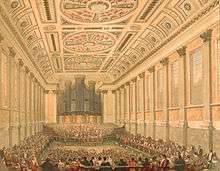
Charles Dickens gave public readings in the building to raise money for the Birmingham and Midland Institute, and Mendelssohn's Elijah and Elgar's The Dream of Gerontius both received their premieres in the hall. Sir Arthur Sullivan's "Overture di Ballo" was also premièred there in August 1870, as part of the Triennial Musical Festival which commissioned new works for every season. The hall was the home venue for the City of Birmingham Symphony Orchestra from 1918 until 1991 when they moved to Symphony Hall.[3]
In November 1880, the Hall was filled to capacity for a Birmingham public protest meeting in support of Revd. Richard Enraght, Vicar of Holy Trinity, Bordesley, who was imprisoned in Warwick Prison under the Disraeli Government's Public Worship Regulation Act.[10] In December 1901, it was the scene of rioting on the occasion of a visit by David Lloyd George.[11]
On 9 August 1902, the town hall, along with the council house, was illuminated in celebration of the coronation of King Edward VII and Queen Alexandra.[12]
In 1937, as part of the celebrations for the Coronation of George VI, the Town Hall was bedecked with the various Arms of the Lord of the Manor of Birmingham since 1166 and each column festooned with garlands. The pediment also had images of Britannia, supported by mermaids, which were sculpted by William Bloye. This decorative scheme for the Town Hall and the whole of the city was devised by William Haywood, Secretary of The Birmingham Civic Society.[13]
Popular music has also featured, and in the 1960s and 1970s, headline acts such as Buddy Holly, The Beatles, Led Zeppelin, Queen, Pink Floyd, Black Sabbath, The Rolling Stones and Bob Dylan appeared.[3]
It featured prominently in the 1967 Peter Watkins film Privilege[14] and doubled for the Royal Albert Hall in the 1996 film Brassed Off.[15]
Renovations
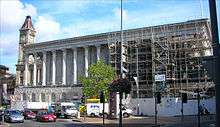
The Hall closed in 1996 for a £35 million refurbishment, undertaken by Wates Construction, that saw the Town Hall brought back to its original glory with its 6,000-pipe organ still in place.[8] The project was funded by £18.3 million from Birmingham City Council, £13.7 million from the Heritage Lottery Fund and £3 million from the European Regional Development Fund. The upper gallery, which had been added in 1926–27, was removed, restoring the interior of the hall to an approximation of its original condition.[16]
The Birmingham City Organist, Thomas Trotter, performed a piece of music to a group of school children in 2005 after the majority of the organ had been cleaned. However, the organist and the children all had to wear hard hats as the risk of falling debris remained. He had played the organ each month from the hall's closure to 2005, thus ensuring that it was maintained in playable condition.[17] The hall is now managed alongside Symphony Hall, by the registered charity Performances Birmingham Limited. At 1,100, the seating capacity is about half that of Symphony Hall.[18]
It reopened for concerts on 4 October 2007,[19][20] and was officially reopened on 22 April 2008 by TRH The Prince of Wales and The Duchess of Cornwall.[21]
During the years of refurbishment the side of the Town Hall facing Victoria Square was hidden by giant advertising sheets, a giant advent calendar, and during the 2002 FIFA World Cup a large outside television screen that was used to broadcast live matches from Korea and Japan. Although the television screen was only temporary, another "Big Screen" was erected on the corner of the building in Chamberlain Square facing Birmingham Central Library, which broadcast live from the television channel BBC One. The BBC Big Screen was removed after much controversy.[22][23][24]
Architecture

The hall takes the form of a free-standing Corinthian temple, with 14 bays running north to south and 8 bays east to west.[7] It is closely modelled on the Temple of Castor and Pollux in Rome and reproduces its predecessor's most distinctive feature – its tall podium – in rusticated stone.[7] The building's columns are topped with capitals featuring Acanthus leaves in a distinctive interlocking spiral design, above which the simplified entablature features a plain architrave and dentil cornice.[25] Behind the colonnade the cella containing the Great Hall features tall windows capped with eared architraves.[26] At the south end of the podium there is an arcade two bays deep, glazed in to form a vestibule in 1995, that marks the main entrance to the building.[26]
The building is constructed in brick made in Selly Oak and faced with Penmon Anglesey Marble presented to the town by Sir Richard Bulkeley, proprietor of the Penmon quarries.[27]
Pipe organ
The town hall is famous for its concert pipe organ. Originally installed in 1834 by William Hill & Sons with 6,000 pipes, it was once the largest and most technologically advanced in the world.[28] In 1888, Charles William Perkins was appointed the first City Organist, based at the Town Hall.[29] The organ was restored by Willis in 1932.[30]
Further pictures
 The columns on the east side of Birmingham Town Hall
The columns on the east side of Birmingham Town Hall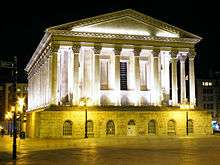 Birmingham Town Hall north end, facing the library
Birmingham Town Hall north end, facing the library Birmingham Town Hall south end, main entrance
Birmingham Town Hall south end, main entrance Birmingham Town Hall west side.
Birmingham Town Hall west side. Birmingham Town Hall and Council House photographed from Victoria Square
Birmingham Town Hall and Council House photographed from Victoria Square Music Festival in 1834 after the installation of William Hill's organ
Music Festival in 1834 after the installation of William Hill's organ
Notes
- Historic England. "Town Hall (1343161)". National Heritage List for England. Retrieved 4 April 2020.
- Harris, Penelope, "The Architectural Achievement of Joseph Aloysius Hansom (1803-1882), Designer of the Hansom Cab, Birmingham Town Hall and Churches of the Catholic Revival", Edwin Mellen Press, 2010, ISBN 0-7734-3851-3
- "Town Hall is now a Grade I Listed feather in Birmingham's cap". Birmingham Mail. 23 June 2015. Retrieved 4 April 2020.
- UK Retail Price Index inflation figures are based on data from Clark, Gregory (2017). "The Annual RPI and Average Earnings for Britain, 1209 to Present (New Series)". MeasuringWorth. Retrieved 2 February 2020.
- Dixon, Roger; Muthesius, Stefan (1985) [1978]. "Monumental Public Architecture". Victorian Architecture. World of Art. London: Thames & Hudson. p. 148. ISBN 0500201609.
The story of Victorian town halls begins with Birmingham.
- Foster 2005, pp. 8–9.
- Foster 2005, p. 58.
- "The Organ". Birmingham City Council. 16 September 2005. Archived from the original on 30 September 2007. Retrieved 17 August 2007.
- "Celebrating the history of Birmingham Town Hall". Business Live. 21 September 2012. Retrieved 4 April 2020.
- G. Wakelin (1895) The Oxford Movement, Sketches and Recollections.
- "Lloyd George escapes at Birmingham Town Hall". Birmingham Images. Retrieved 4 April 2020.
- Reekes, Andrew Edward (1 March 2014). "Birmingham Exceptionalism: Joseph Chamberlain and the 1906 General Election" (PDF). University of Birmingham. Retrieved 4 April 2020.
- "1937 Birmingham Coronation Brochure" (PDF). Birmingham Civic Society. Retrieved 4 April 2020.
- "Privilege". Reel Streets. Retrieved 4 April 2020.
- "Brassed Off". IMDB. Retrieved 4 April 2020.
- Peers 2012, pp. 192–194.
- Peers 2012, p. 191.
- Hall's well – Birmingham's revived Town Hall is a world-beater – Times Online, 29 September 2007
- £35m restoration brings Town Hall back to life – Birmingham Post, 5 October 2007
- Town Hall comes out of the shadows – Birmingham Post, 5 October 2007
- TRH spend a day conducting engagements in the West Midlands, 22 April 2008
- Chamberlain Square big screen `an eyesore` – Birmingham Mail, 5 April 2007
- No permission but big screen remains – Birmingham Post, 9 May 2007
- Plug is pulled on big screen – Birmingham Mail, 25 May 2007
- Foster 2005, pp. 58-59.
- Foster 2005, p. 59.
- "Quarry supplies £30m hall refit". BBC. 18 February 2003. Retrieved 4 April 2020.
- "Pull out all the stops". The Guardian. 26 October 2007. Retrieved 4 April 2020.
- "Charles William Perkins, the City Organist". Handsworth. 1 (11). May 1895.
- "Birmingham Town Hall pipe organ specification". National Pipe Organ Register. Retrieved 4 April 2020.
References
- Harris, Penelope (2010). The Architectural Achievement of Joseph Hamsom (1803–1882), Designer of the Hansom Cab, Birmingham Town Hall and Churches of the Catholic Revival. Lampeter and New York: The Edwin Mellen Press. ISBN 0-7734-3851-3.
- Holyoak, Joe (1989). All About Victoria Square. Birmingham: The Victorian Society Birmingham Group. ISBN 0-901657-14-X.CS1 maint: ref=harv (link)
- Foster, Andy (2005). Pevsner Architectural Guides – Birmingham. New Haven: Yale University Press. ISBN 0-300-10731-5.CS1 maint: ref=harv (link)
- Peers, Anthony (2012). Birmingham Town Hall – An Architectural History. Farnham: Lund Humphries. ISBN 978-1-84822-074-4.CS1 maint: ref=harv (link)
- Thistlewaite, Nicholas (1984). Birmingham Town Hall Organ. Birmingham: Birmingham City Council. OCLC 30721233.CS1 maint: ref=harv (link)
